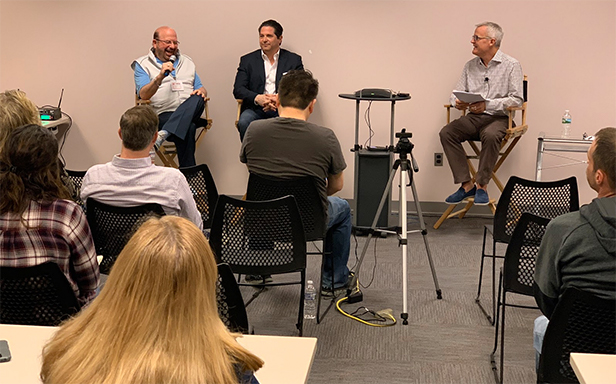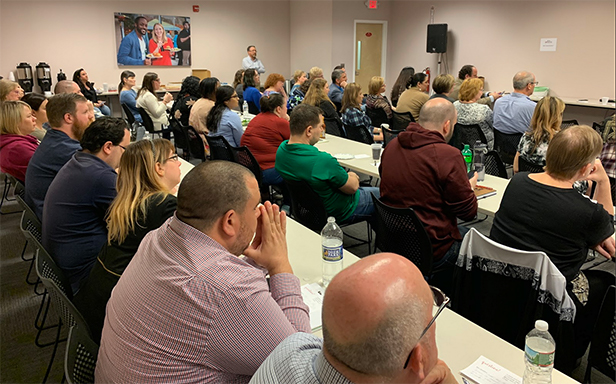Strategy April 12, 2019
ASI Hosts Panel Session With Geiger, Hit Executives
More than 100 employees listened to a discussion about the state of the promo marketplace.
This week, ASI welcomed Fred Snyder, vice president of sales for the Eastern region for Top 40 distributor Geiger (asi/202900), and Brett Hersh, executive vice president of Top 40 supplier Hit Promotional Products (asi/61125), for an expert panel discussion moderated by ASI president and CEO Tim Andrews.

From left to right: Fred Snyder of Geiger, Brett Hersh of Hit Promotional Products and ASI president & CEO Tim Andrews.
Over 100 ASI employees attended the hour-long event, hosted by the PeerLink Committee comprised of ASI colleagues dedicated to leveraging in-house career resources. Hersh and Snyder answered promo marketplace-focused questions from the audience.
Geiger is the oldest distributor in the industry (founded in 1887 in Newark, with headquarters now in Maine) and is also the largest privately-held distributor firm. In 2017, the company brought in $186 million in revenue. Hersh, the founder of supplier Admints that he sold to Hit in 2015, is part of a large enterprise that brought in $450 million in revenue in 2018, with more than 1 million total square feet of warehouse space that contains approximately $100 million in inventory across the country.
Snyder opened the conversation by talking about what makes a distributor successful in the current promo landscape. “Distributors need tangible reasons for clients to work with them,” he said. “So many are already buying promo products from their best friend. They need a differentiator that the client can’t live without, and they need to be out there, networking constantly and being present on social media. They also need to be working to get even more business from existing clients.”
Making the B2B relationship even more challenging is the changing clientele. Snyder said many buyers now are Generation X and Millennials, who are comfortable with technology and social media, and have no problem with visiting a distributor website and making a purchase there. That’s all well and good, he said, but there still has to be a relationship established if the distributor wants recurring business.
“The old school reps bring lunch, show products, kibbutz a bit,” he said. “Texting and social media are tools, and a sales rep’s craft is using them to their advantage. They have to be a jack of all trades. Buyers now will try to put them off – they didn’t used to do that. You have to be creative to get in there. When we’re there physically, we get jobs we weren’t expecting because all committees at a company like to have their own promo products.”

ASI employees attended the exclusive event, hosted by the ASI PeerLink Committee.
Face-to-face time is all the more important given the speed at which new products are being introduced into the industry. While new releases were traditionally unveiled in January, at the start of the trade show season, Hersh said Hit announces new offerings all year round. In 2018, they had 720 new items, an average of two a week, many of them retail-inspired. He travels to China several times a year to see what’s trending and ask vendors about their capabilities.
“We have a great Product Development team that brings us relevant products,” he said. “It’s allowed us to make sure we have everything that a distributor’s client would ask for when it’s trending at retail, not a year later.”
When asked about the attributes of an ideal supplier partner, Snyder mentioned financial stability, a commitment to safety and compliance, and value-added services. “Hit has a sales rep just for Geiger, so they know us and our people,” he said. “They’ll come with us on a sales call. With over a million products in the industry, we rely on supplier reps to tell us what’s new. The real key is communication. And we need assurances that the products are safe.”
Hersh continued by discussing an ongoing challenge for suppliers that hasn’t improved much over the past few years: incomplete orders. And it’s not an oversight reserved for smaller clients.
“Order management is 100% the biggest challenge for suppliers,” he said. “It’s the broken link of the industry. Everyone’s order is for their biggest client, and they needed it yesterday, but we constantly get incomplete orders.”
Snyder added to Hersh’s comments by mentioning a huge factor to the disconnect: order entry inconsistencies. Unfortunately, by the time an order is being processed by a supplier, it’s often been given the “whisper down the lane” treatment, where the request might look different from what it was originally. And so many different people are putting in order data.
“There are 20,000 distributor firms now, and people ages 20 to 80 are entering information into the system, and there are all different ways that that information is being put in,” he said. “Even the same product might be called two different things at two suppliers.”
It’s a matter of synching supplier and distributor order systems; Hersh said Hit is capable of doing that.
“We’re ready to integrate with any distributor who’s ready, willing and able,” he said. “That’s the most important part of staying competitive and relevant.” Both Snyder and Hersh encouraged ASI to continue developing ESP to make the order-synching process as seamless as possible.
Andrews also asked Hersh and Snyder about venture capital coming into the industry, and what the impact will be. Snyder said he thinks the consolidation that has resulted is a good thing.
“This used to be mostly a cottage industry with tens of thousands of people, and I think it held the industry back a bit,” he said. “Consolidation fuels the need for technology, to make things more efficient. So companies will partner with a distributor like Geiger because they can’t afford the tech needed for an Amazon experience. It’s hard to compete with the 4imprint model.”
Hersh called consolidation “a natural progression when there’s opportunity,” and said that venture capital investments in the industry have undeniably changed its face and expanded its reach. “The core business is still there and growing,” he said, “but we have to pay attention to international sales.”
The influx of funding means industry companies will have to pivot to stay competitive as the marketplace evolves rapidly. “The industry is due for a dramatic change,” said Snyder. “It’s slowly creeping up because there’s huge money behind it now. It’s a global market, and business has to be done differently to keep up, continue growth and increase margins.”
